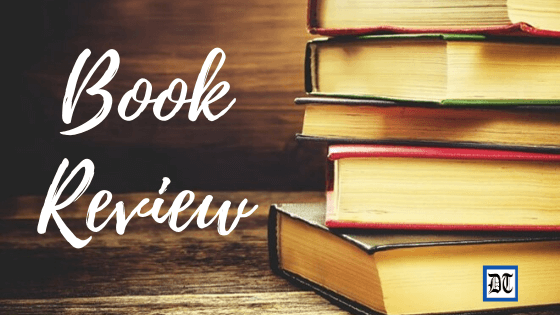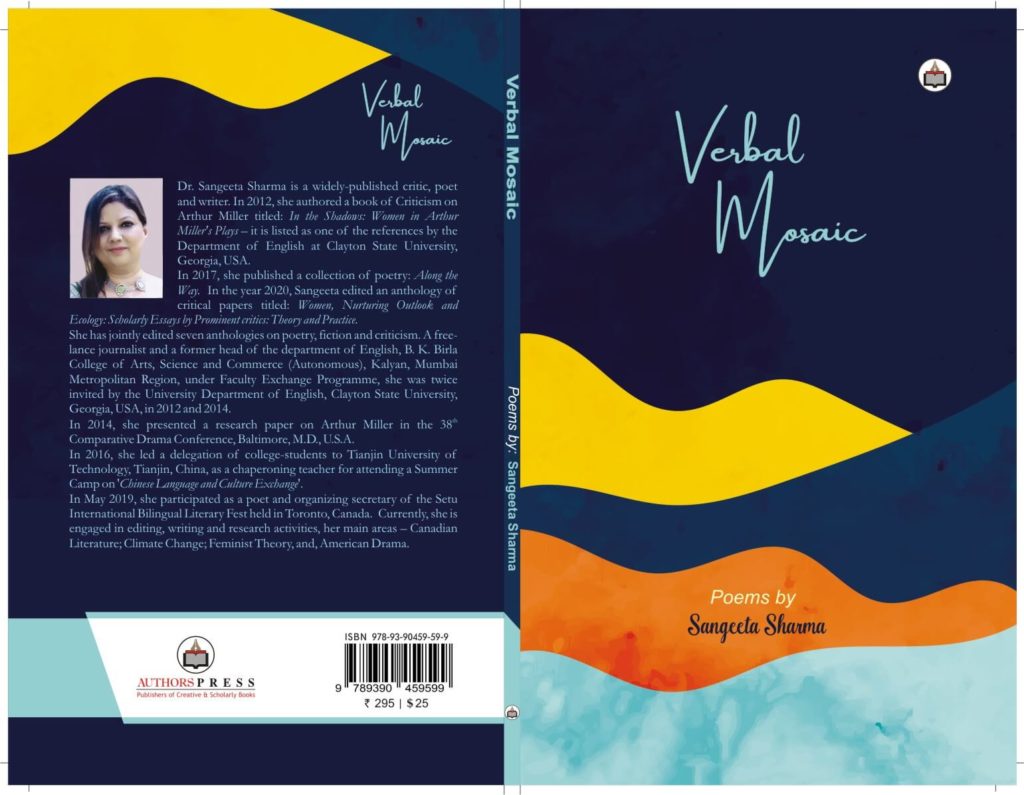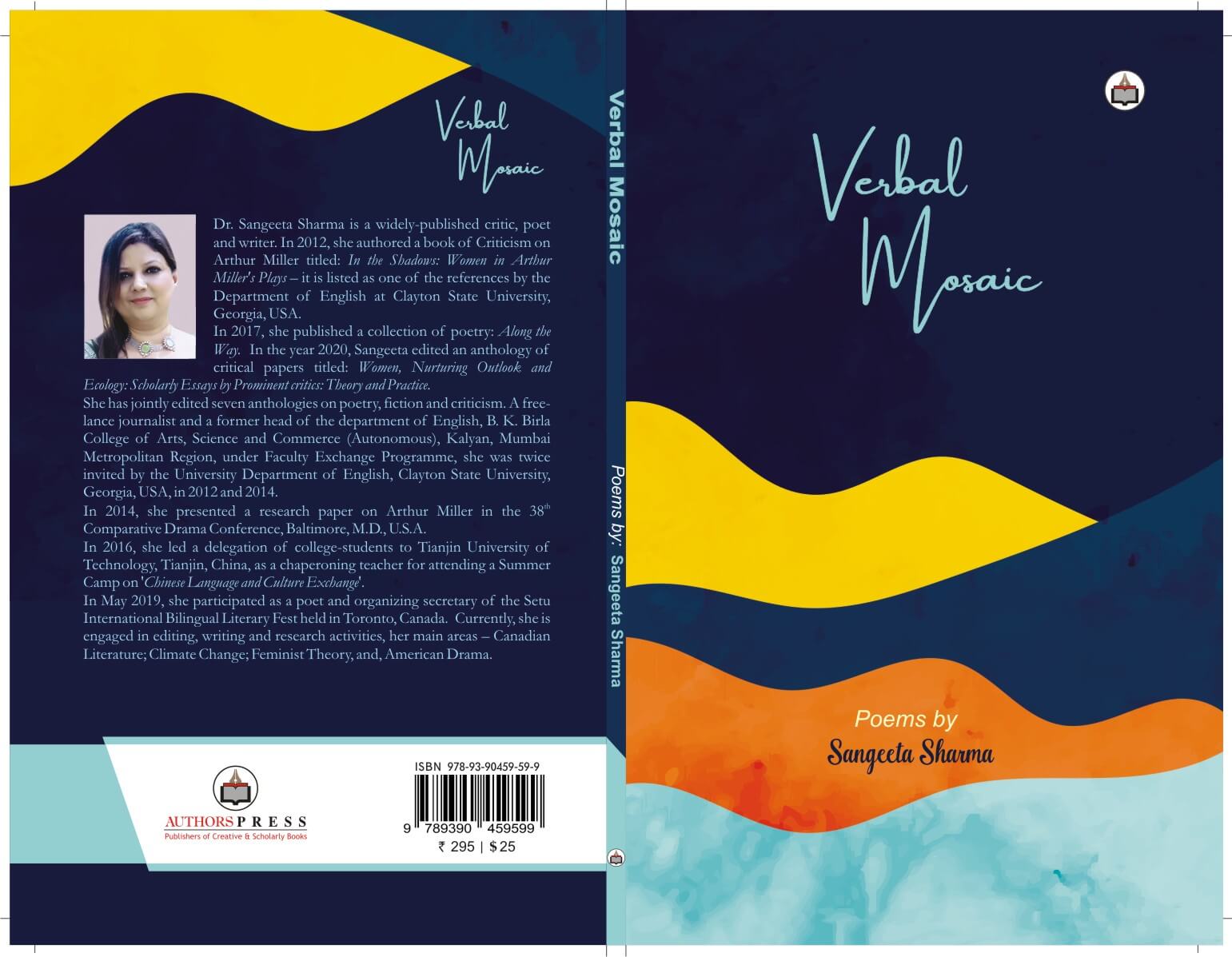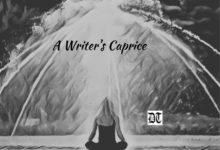Dr Meenakshi reviews a book of poems, Verbal Mosaic, by Sangeeta Sharma – an exclusive for Different Truths.

It’s your road and yours alone
Others may walk it with you,
But no one can walk it for you.
RumiThe above quote by Rumi kept ringing in my mind as I read Sangeeta Sharma’s poems in Verbal Mosaic. Isn’t it true that we are traversing our journey in this world, some by our own making and some by destiny? Yet, few have lenses to look at the world – different and unique from others?
Verbal Mosaic, a collection of seventy poems, is a parable of Sangeeta’s epiphanic moments of life, reflecting her varied emotions and mindsets vividly captured in her verses. Gopal Lahiri, in the ‘Foreword’for the book, says:
“Sangeeta Sharma offers insight into the details of everyday situations, disparities against women, emotions, and the nuances of life in this bipartisan world. The poet is as if on an endless journey through scenes of the human heart arrested and restored in verses.”
I see this book as a magical den in which Sangeeta has caught the fluid realities of life …
I see this book as a magical den in which Sangeeta has caught the fluid realities of life and explored themes of feminism, migration, Covid-19, human birth, urban life, nature, and historical events, to name some of them. Her empathy for the proletarian class reflects in ‘In the Tropics’, ‘Construction Workers’, ‘Tribute to a Corona Warrior’, ‘Dharavi – Asia’s No. 1 Slum Area’ and ‘Migrants’, et al.
Moreover, she has the niche of noticing imperceptible but significant aspects of life and fills its readers with awe, anguish, helplessness, despair, hope, and happiness. Sangeeta states in the Preface:
“Life is a mélange of joy and sorrow, laughter and tears, longing and loathing, and hope and despair. But irrespective of the temporal moment, the Circle of Time (Kaalchakra) continues. It does not wait for anyone to get up after a great fall, nor does it go faster for you to catch the falling star ….
An artistic eye provides an epiphany – a new perception of the humdrum and makes the familiar unfamiliar. Discerning such beauty and truth in the mundane around us makes the poet an extraordinary human being who has the power to look beyond, inside, and ahead of what meets the eye. (11)”
Women’s issue seems to be one of the most significant elements in this collection.
Women’s issue seems to be one of the most significant elements in this collection. In her poem, ‘I am not a Robot’,I see her as stressing that women are not robots, dancing and pleasing everyone’s whims. They have identities of their own:
Enough! Don’t treat me like a machine! I am sensitive, A person Who needs to be recognized To be acknowledged …. I am a flesh, blood, and breath Human being Mind it! I am not a robot I refuse to be one! (23)
I see Maya Angelou’s Phenomenal Woman raging through Sangeeta’s words when Angelou says, “It is the fire in my eyes … I am a woman phenomenally … that is me.”
An ecofeminist to the core, Sangeeta, in her poem, ‘The Woman’, documents connections between women and the environment, both of whom have borne patriarchal domination. To garner respect for them, she raises her voice for these stoics, who have always resisted exploitation. Metaphorically, she has compared women to the holy mythological characters. She says women are as powerful as Goddess Durga and knowledgeable as Goddess Saraswati. She has likened women to Goddess Sita and Draupadi, who were vulnerable yet emerged triumphant in their way. At the end of the poem, she calls Nature and women, both the progenitors and nurturers:
She is the Durga Who combats evils She is the Kali Up in arms, Annihilating the iniquitous, Swaying her sword n scimitar She is Saraswati, The goddess of knowledge, music, and art Revered all around. …. She is the Mother And she is the Nature Both progenitors And both nurturers – who help create, sustain n proliferate…” (32)
With the same eye, in the poem, ‘Peacock’, she mourns the plummeting numbers of the Indian national bird and how they need to be conserved:
“Encroachment, poaching And scarcity of water- the main causes Of the plummeting numbers Calls for conservation measures.” (73)
And in “Medusa, Slayer of Perseus”, the theme of woman-shakti continues…
And in “Medusa, Slayer of Perseus”, the theme of woman-shakti continues when she says, “This empowered self of Gorgon Medusa guides us through our terrors, lifts us from the dark depths of fear….” And then, Sangeeta recounts in her poem, “A Reality Check”, “A new woman wants to earn, splurge, and enjoy….”So while on one side of the coin, I see Sangeeta emphasizing the shakti element of a woman who has power and independence and who is not a Robot, and on the flip side, she describes the woman as a cog in the wheel who is a nurturer and keeps the family together by saying a woman is a cog in the wheel of the family who keeps it going round and round, day in and day out. Her poem, “Predicament of a Woman”, is heart-wrenching in which she portrays her as the one who can forget her pain and sufferings to fulfil her responsibilities for the love of her family:
Twice a month, She braves the therapy Chemo, a long agonizing …. The valiant homemaker Before going to hospice Cooks, cleans, and washes Dutybound and grateful…. (30)
‘Dharavi’, ‘Construction Workers’, ‘Migrants’, and ‘Widows of Pulwama’show Sangeeta’s sensitivity and sagacity in looking deep into human characters and sufferings. With a lump in my throat and eyes brimming with tears, I read the following lines from the “Widows of Pulwama”:

Their hearts wrench with pain They holler and howl But reverse could not The mishap in which they lost Their precious darling husbands The widows of Pulwama victims …. Money, tributes and assurance Can never compensate the cataclysm Still the patriotism The valiant widow, nonetheless Is all set to make her sons Follow their father’s footsteps. (25)
Sangeeta has also talked about the catastrophes Corona has caused both at the micro and macro levels. She resonates with the feelings of Erik Pevernagie in her poems: ‘Covid-19 in India’, ‘Covid-19’, and ‘Tribute to Corona Warrior’ when he says, “The global Corona conflict has rammed people in trenches … it is difficult to tell how we can call a truce with imperceptible enemies.”
Corona has shackled the world into chains binding us with fear and helplessness.
Corona has shackled the world into chains binding us with fear and helplessness. Sangeeta says in her poem ‘Covid-19’:
Everybody huddled in the confines of home, Praying for their well-being and for their loved ones Like marionettes, To Earth’s Fury… (85
But how can a young child’s mother, a nurse by profession, explain this to her son when she tends to patients in the hospital? Her dilemma is evident in her poem, ‘Tribute to Corona Warrior’:
He wants to cuddle her But she can’t afford the touch … Lingering morbid thoughts upsetting her… But then who will cook for her fatherless kids While she’s in the hospital nursing… And when at home she dreads She must have caught infection from the five Who have tested positive (81)
Sangeeta’s poems read like stories.
Sangeeta’s poems read like stories. In simple words, she beautifully knits vivid imagery and poignant emotions. Some of her poems talk about spiritualism and philosophy. The realm of spirituality is mystical, and when we look at the world through positive lenses, we become aware that despite treacheries in life, the world is filled with spiritualism, beauty, and hope. In her poem, ‘Power’, Sangeeta prays:
For me, there is some higher power That pulls me through … May I beg that great power To help me navigate This great ocean called “LIFE” Enjoyably and peacefully? (77)
And in ‘Hope’, she convinces herself that hope is that light that keeps one alive even in the dimmest of lanes. Sangeeta Sharma is a prolific critic, poet and writer, published widely at the national and international levels and is also one of the editors of the Setu Bilingual Journal. She has been an undergrad teacher for nearly three decades in India before settling in Canada.
Verbal Mosaic, a montage of the most enlightening moments, epiphanies, and milestones of Sangeeta’s life, is her second collection of poems, which she beautifully assembles into this book form.
A believer in ecotherapy, lakes and waterfalls have an embalming and healing effect…
A believer in ecotherapy, lakes and waterfalls have an embalming and healing effect, as expressed in ‘Halcyon’, ‘Lake Ontario’, Niagara Falls’, and others.
An ardent lover and worshipper of nature, she finds it a constant source of inspiration and power.
In Keatsian style, she calls ‘Nature’ the truth of life as it has the power to delight, uplift and heal us from within. In ‘Halcyon’ she describes:
Velvety sapphirine clots Making a slow movement In the sky The super beatific sight! Looking aloft and below is inspiring Heavenly An epiphany: Nature is Truth And Truth, Nature- Nothing beyond And Nothing beside! (42-43)
Gopal Lahiri further attests in the Foreword:
“Some of her poems are fresh and sharp with an eye for detail. The poet, at times, has woven her words on a broad canvas in which past and present blur in impossible nostalgia. The poet captures the emotion and wistfulness beautifully and elegantly.”
Verbal Mosaic is a must-read – the words of this book would stay with readers for a long time.
Visuals sourced by the reviewer





 By
By

 By
By
 By
By